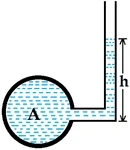manometer
It is a device in which the pressure of a fluid is measure. and in simple language, manometer is a pressure measuring instrument.
Simple manometer
A simple manometer is one which consists of a glass tube whose one end is connected to a point where pressure is to be measured and the other end remains open to atmosphere. So there are two types of manometer, one is (1) Piezometer and other is (2) U-tube manometer.
See also this : Working of 4 stroke petrol engine
Piezometer
A Piezometer is the simplest form of manometer which can be use for measuring moderate pressures of liquids. So it consists of a glass tube inserted in the wall of a vessel or of a pipe, containing liquid whose pressure is to be measured.
In the piezometer tube other end is open to the atmosphere. So The rise of liquid gives the pressure head at that point. Hence If at a point ‘A’ the height of liquid say water ‘h’ in piezometer tube. Then pressure at A = αgh N/m2

Advantages of piezometer
- Simple construction
- Not expensive
- Easy to take reading
Limitations of piezometer
- Not suitable to measure negative and high pressure.
- Brittle
- Parallel effect affect correct reading
See also this : What are the properties of fluids
U tube manometer
Generally piezometers cannot be employed when large pressures in the lighter liquids are to be measured, Since this would require very long tubes, which cannot be handled conveniently.
So this U-tube manometer consists of a glass tube bent in U-shape, one end of which is connected to a point at which pressure is to be measured is to be measured and other end remains open to the atmosphere.
(1) For positive pressure
Let us consider ‘A’ be the point at which pressure is to be measure. and X-X is the datum line as shown in the fig (1)
Let h1 = It is the height of the light liquid in the left limb above the datum line.
h2 = Height of the heavy liquid in the right limb above the datum line.
See also this : Explain working of 4 stroke diesel engine

h = Pressure in pipe, expressed in terms of head.
S1 = Specific gravity of the light liquid.
S2 = Specific gravity of the light liquid.
The pressure in the left limb and right limb above the datum line x-x = h+h1 s1. So in the right limb pressure head above x-x = h2 s2. Hence equating these two pressure, then we get h+h1s1 = h2s2.
| So h = h2s2 – h1s1 |
(2) For negative pressure
It has been shown in the figure (2) In the left limb pressure head above x-x = h+h1s1 + h2s2. So In the right limb pressure head above x-x = 0. Hence equating these equation, then we have h+h1s1 +h2s2 = 0.
| So h = – ( h1s1 + h2s2 ) |
See also this : Explain steam engine
